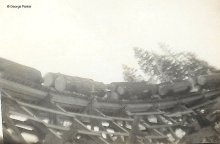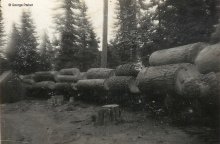It was the summer of 1941. I was the "extra man" in the camp. First, it was a few days limbing. I thought it would be a snap, but it was the hardest job I had. Swinging an axe all day long in impossible positions. This was the job after the tree had been fallen (you don't say felled in the woods). Starting at the base, there were few limbs 'till you reached about 50 feet up and then one had to work on top, beneath, and on the sides of the tree to cut limbs that were up to a foot in diameter.
I was glad to be taken off that job and put on choker setting. This meant dragging 30 foot long 3/4 inch cables, with a hook on one end and an eye on the other, through the brush and fastening them around the ends of logs. Then when the cat (tractor) arrived, unhooking the empty chokers they brought back, and attaching the new logs to be hauled to the landing. Dragging the chokers through the brush could be tough, but there was often a break waiting for the cat to return. That job lasted until a permanent logger arrived from the employment agency in Sacramento.
Next, I was assigned to work with Bill Berry, the forester. One morning we arrived at the site of a new landing where the donkey was just pulling itself off of a flat car to its setting. It's an interesting sight to see it pull itself ashore with its own winch, and a cable wrapped around a tree trunk. The train crew then began reconnecting the engine to the large steel-clad donkey car, when things went awry. The track was curved at this point and the brakeman, standing on the front footboard, was positioning the connecting bar from the engine to the car, when his hips were squeezed between the edge of the car and the engine. He screamed and collapsed. The camp boss, Alec, who was superintending the operation, pointed to me and said "George, you're a brakeman now". We placed the injured brakeman on the flat car, and took him into camp where my father took him by car to the hospital in Placerville. We never heard the extent of his injuries, nor did he return to camp.
There is a term used in the woods pertaining to young workers. The word is "punk". It has a variety of meanings in society: it might be the smoldering device you use to ignite fireworks; it could pertain to young tough guys scribbling their logo on the side of a building; or, heaven forbid, punk rock. Then, again, it might be a young boy preferred by men, as in early Greece. You might call this paragraph an "Ode on a Grecian Yearn". But here, it pertains to new young men or boy workers. In fact, in the days of high-line logging, before cats, a lad, whose official title was "whistle punk", strung a wire from the whistle of the donkey out into the woods where he could hear the choker setter's commands, and then pull on the whistle so the donkey puncher could pull the logs in.
It's tough on an older, seasoned worker to have a punk kid come along (especially if he is a college boy) who might have a job where he gives, or passes on orders to him. It irks him; it can possess him. He will get over it in a while, but will try to make it hard on the newcomer at first.
Pete Borromini was one of these seasoned men. He had been the engineer of the 9 spot for many years, and knew and loved that locomotive like a wife. He knew all that was to happen in the daily runs, and even though the conductor was nominally in charge of the train, Pete ran the train. The conductor, Frank Kessler, pulled me aside and told me that the first time I was to connect cars Pete would come in too fast, either to scare me, injure me, or to get me to quit. "Just step back, don't try to make the connection, and signal Pete to come in again. Eventually, he has to give in". Sure enough, this is what happened, and after the fourth attempt, he closed in slowly and I made the connection.
These logging cars had "link and pin" connections. The links were about 8 inches long. The procedure was to step forward, with one foot between the tracks, and the other behind the rail. With one hand pull the pin from the stationary car, reach for the link of the approaching car with the other and guide it into the draw head of the stationary car, pull your hand away quickly, slam the pin down and step back, away from the cars, for they often moved a bit. There is plenty of room for injury here.
Before long, Pete and I got along fine. I had known him since I was 8 years old, had played with his daughters, knew his wife and his brother-in-law Pearl Pratt, who was his fireman on the Number 9. Maybe this is part of the initiation for newcomers, a "passage of rites", that must be exercised.
Life is a breeze when running a string of empties. The conductor sits on a bunk of the last car and the brakeman in the middle of the train, ready to pass on any signals that may be necessary. Chances are no brakes need to be set, for the engine can control the string. But, when you are running 20 cars of logs down to the mill, it's a different story. The engine had air brakes, but the cars were hand set. When you have a flat stretch of road, you want no brakes, but when you get on a descent, brakes on the cars must be set, for the engine can't hold the train alone. The brakeman and conductor ride on top of the logs, fifteen feet in the air swaying back and forth on the 3 foot track. Climbing up on the load can be a problem and you don't want to do it while the train is moving. When changing from a flat run to a grade, or vice-versa, the train is stopped, so the brakemen can descend, set, or knock off brakes, then climb back on top of a load.

All in all, it was an easy job: taking the cars down to the unloading spot at the mill; watching the logs from each car get splashed into the pond; heading back to camp with the empties; stopping only to load wood on the engine and fill the water tank, and then home. One trip, heading for Pino Grande, the mill, as I sat dreaming atop a swaying car, I snapped back to reality, when I felt that we were going faster than normal, and faster and yet faster. I had been sitting side-saddle, but now I straddled the log for better security, Something must be wrong! And, then, I heard it: a continuing series of short but screaming angry blasts from the engine whistle, with the full 140 pounds of steam behind them. This was not the feeble toot-toot-toot to shoo cows off the track, No!, this was the "washout signal" meaning the engineer could not control the train. The whistle said "jump!, jump!, jump!". And, jump I did! There was a high bank on the upper side of the track. Without thinking, I leaped for it, but fell short, landing on the side of the bank and sliding along and down, rolling over and over, as my gymnastic training had taught me, until I came to rest near the track.

I waited until the train had passed, and here came Frank, running after the train. I joined him, the two of us still carrying our brake hickies, and soon had another member of the crew with us, Pearl, the fireman. The three of us trotted along the track like characters out of the Wizard of Oz, seeking Pete, the Wizard - the only one who might stop the train.
The question is: does the engineer go down with the train as does the captain of a ship? Does he ride it to destruction? Is it part of their code of honor? I'll never know, for after running for a mile or so, there was the train, waiting for us. Pete had saved the day. And I, once before, when working on the landing, had not set enough brakes, and now, I had failed again.

